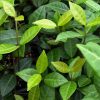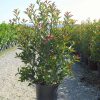There’s nothing more breathtaking than the bright colored blooms and elegant foliage tropical plants provide through the spring and summer months. Tropical plants give us the opportunity to enjoy the exotic look of Hawaii, Mexico and other tropical regions right here in our own front or backyards. These plants can be added to almost any landscape. Weather its hibiscus, bougainvillea or Mandevillias it’s hard to resist planting at least one or two tropical plants each season. Tropical’s come in many sizes, shapes and colors. Along with their awesome color displays they also offer many unique choices for foliage in various colors, shapes and sizes.
Here are some local favorites for tropical foliage and color
Flowering Tropical’s
Bougainvillea: This plant produces large masses of brilliantly colored pink, red, yellow and orange blooms all summer long. Use in hanging baskets or patio containers. They can also be attached to trellises or arbors for a larger display of color. Train them into a bush or plant in containers around the landscape. Bougainvilleas require good drainage and lots of sunshine. For best blooming results allow the dirt to dry out completely before each watering and feed with a water-soluble fertilizer like 20-20-20 once or twice a week.
[divider]
Mandevillia:
This plant has become more popular over the last several years. With its bright pink, red or white blooms it’s sure to brighten any patio, porch or garden. Use in hanging baskets, planters or plant directly in the garden. Mandevillia require at least 4-6 hours of sunlight to continue blooming throughout the summer months. Feed with a high phosphorus (P) fertilizer, 15-30-15 works s well.
[divider]
Tropical Hibiscus:
Tropical Hibiscus are probably the most recognizable and popular tropical plants used in today’s landscapes. Tropical Hibiscus offers a wide array of colors and blooms types including single and double reds, pinks, yellows and oranges. They can also be trained into patio trees, used as bushes, there’s even some that have braided trunks. Make sure to keep them moist and for continued blooming throughout the season feed with ColorStar 19-13-6[divider]
Ixora:
Ixora’s is a sun loving tropical plant with large clusters of blooms in vibrant colors of red, orange and yellow. Use in planters on the patio or plant directly in the garden for a truly tropical feel. Keep this plant evenly moist but not wet. Feed with a high nitrogen (N) fertilizer like ColorStar 19-13-6
[divider]
Passion Vine:
This Tropical blooming vine has fragrant and unique blooms in shades of blue, violet, purple and more. With is height reaching 20’ tall. Requires good drainage. Water regularly but do not over water. Requires full sun but will perform well in part shade. Feed with ColorStar 19-13-6
[divider]
Fuchsia:
Tropical vine or bush varieties available. Does well in hanging baskets or planters. Requires full to part shade for best results. With beautiful pink, white, purple, or red bi-colored blooms. Grows 18 to24” tall. Average water needs, keep evenly moist but do not over water. Feed with ColorStar 19-13-6
[divider]
Tropical Foliage
Boston Fern:
Beautiful Tropical Fern, mounding to 2-3’ tall and wide. Use in hanging baskets and planters as well as in the garden. Does best in full to part shade. Keep evenly moist but not wet. Thrives in areas that receive high humidity. Feed with a balanced fertilizer like 20-20-20[divider]
Copper Plant:
This brightly colored Tropical shrub has beautiful copper to red colored foliage throughout the plant. Grown for its large copper colored leave. Does well in heat and sun. Small inconspicuous pink blooms appear late spring to early summer. Requires average water, do not over water or allow to dry completely. Grows 12-18” tall. Feed with Color Star 19-13-6
[divider]
Philodendron:
Fast growing tropical shrub with large dark green foliage, growing 12-15’ tall and wide. Requires sun to part shade. Grown for its beautiful large showy foliage. Water regularly but do not over water. Feed with high nitrogen (N) fertilizer such as Colorstar 19-13-6[divider]
Tropical Palms
Mexican Fan Palm:
This excellent Tropical Palm Tree adds a tropical feel to any landscape and has been known to reach a height between 20-30 feet tall in our climate. Plant where it will receive full sun and feed your palms with a food that is specifically labeled for palms. Palms require winter protection so don’t forget to cover with burlap or other breathable cloth during extreme temperatures below 32*
[divider]
Sago Palm:
Beautiful Tropical Palm Tree with deep dark green foliage, Grows 6-10’ tall. Sago palms prefer to be planted in full sun but will tolerate part shade. Water regularly but make sure soil drains well and does not stay wet. Feed with a specific food labeled for Palm Trees. Protect the trunk from extreme temperatures below 32* by wrapping with burlap during long periods of cold.
[divider]
Unique Tropical Palm Tree in that it withstands more cold than most other palms. This palm actually grows natural burlap around the trunk that allows it to withstand cooler climates than most other palms. Does well planted in full sun to part shade and grows upwards of 20’ tall. Windmill Palms also do well in drought conditions. They should be watered regularly, but be careful not to over water. Feed with food specific to palm trees. Protect from extreme temperatures below 32* by wrapping it with burlap or other cloth materials.
[divider]
Climate Caution!
When we use the term Tropical we are referring to plants that otherwise require a warmer climate than ours, this means that they usually will not withstand the excessive cold temperatures that at times we receive. With that being said, we have to understand that most of these plants will require winter protection in order to survive. In order to enjoy them from year to year one of the best ways to protect these plants is to move them to a warmer area. These plants can be brought inside the house or can be stored in a heated garage or greenhouse during the colder months of the year. Or in the case of larger plants like palms, we need to protect them by covering them.



